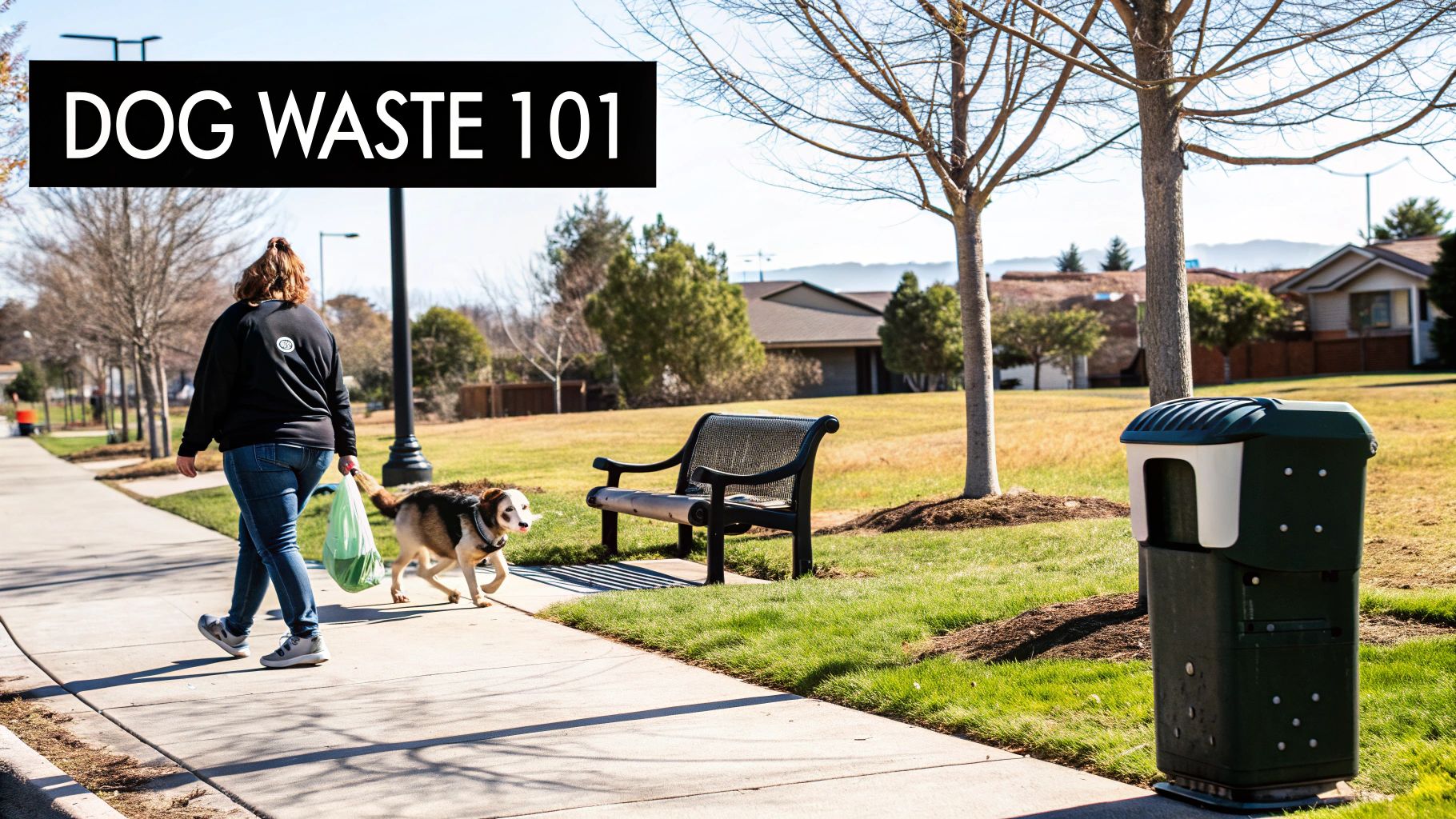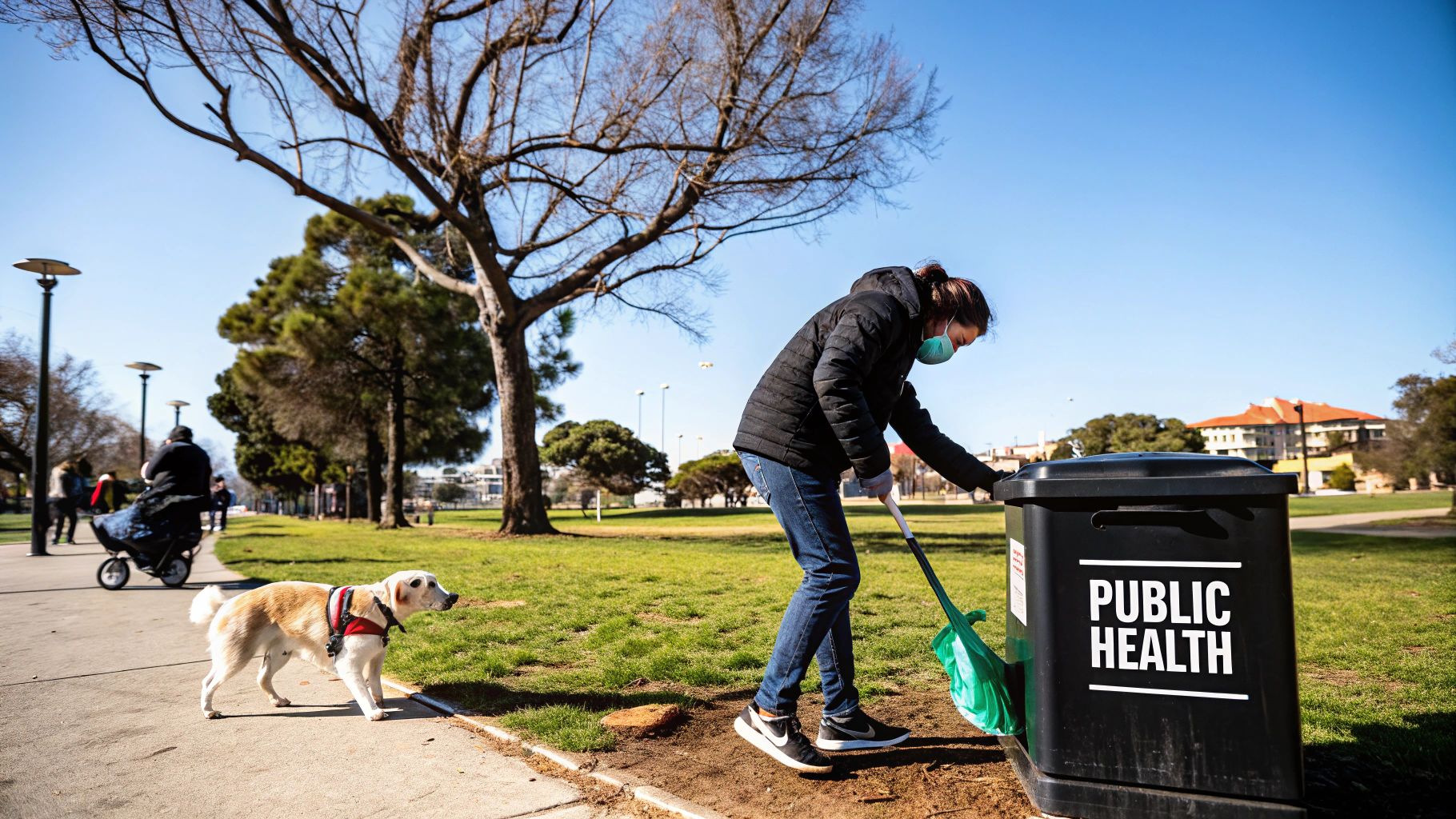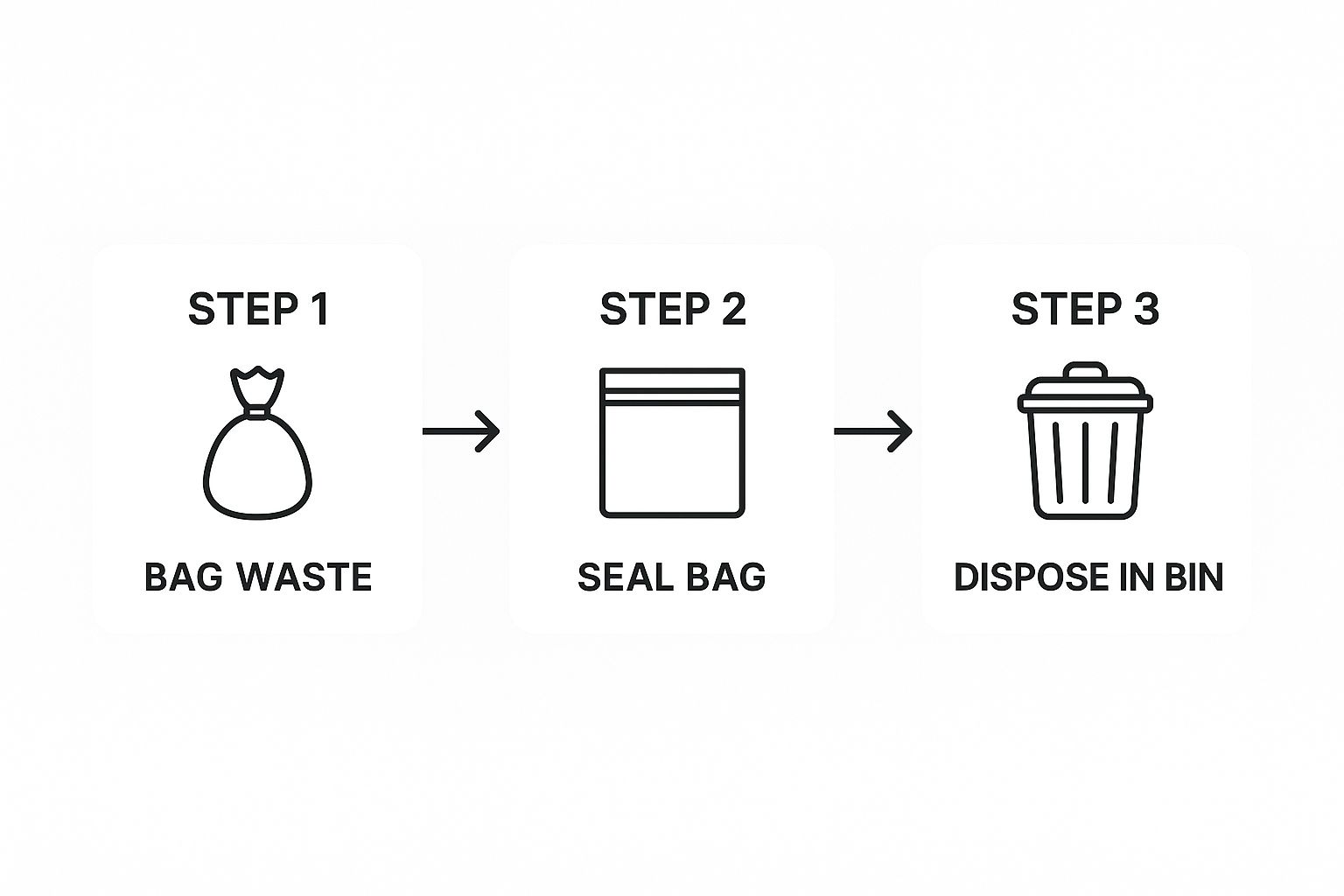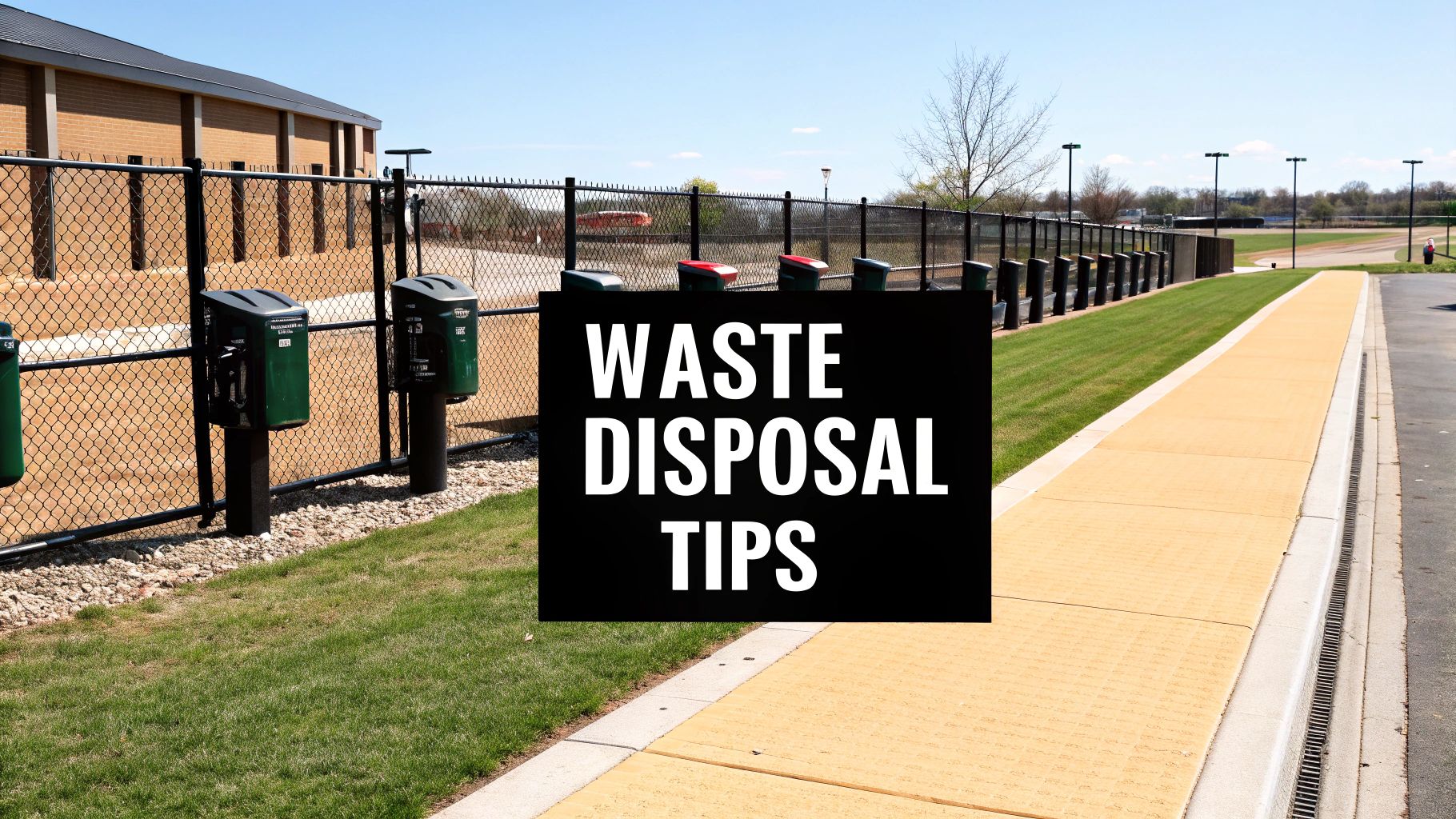Photo by james chan on Unsplash
Every dog owner knows that daily walks come with a certain… responsibility. No matter how adorable your pup is, picking up after them isn’t exactly the most pleasant part of the routine. But what if it didn’t have to be such a hassle? What if you could enjoy your walk without juggling leashes, bags, and that awkward moment of figuring out where to stash the poop until you find a bin? That’s where hands-free doggie waste disposal comes in — a simple yet game-changing solution that makes life with your furry companion a lot cleaner and easier.
Hands-free systems are designed to take the mess (and the stress) out of pet cleanup. They let you carry, contain, and dispose of waste without ever having to hold a bag in your hand. Whether you’re hiking, jogging, or just enjoying a relaxed stroll around the block, these clever tools keep your hands free and your walk worry-free. In this guide, we’ll explore how hands-free waste disposal works, the types of tools available, and why every dog parent should consider making the switch.
Rethinking Your Daily Cleanup Routine
We’ve all been there, doing the awkward "bend and scoop" with just a thin plastic bag between our hands and… well, you know. It’s clumsy, sometimes messy, and frankly, a little too close for comfort. That daily ritual can really take away from the simple joy of being out for a walk with your best friend.
A modern approach to dog waste disposal isn’t about some flashy new gadget; it’s about upgrading your routine for better hygiene and a more pleasant experience. The goal is to create a true barrier, eliminating that direct contact for good. Imagine never having to feel the warmth or texture through a bag again.
Why Hands-Free Disposal Actually Matters
This is about more than just avoiding the "yuck" factor. Shifting to a hands-free method has some real, practical benefits that just make life as a dog owner better.

- Next-Level Hygiene: By putting a tool between your hand and the waste, you’re dramatically cutting down the risk of contact with nasty bacteria and parasites.
- Grab-and-Go Convenience: These systems clip right onto your leash or belt loop, so your cleanup tool is always there right when you need it. No more forgetting bags or juggling leashes.
- A Genuinely Better Walk: When you take away the single most unpleasant part of the walk, you can actually relax and focus on what’s important—enjoying that quality time with your dog.
Adopting a better cleanup method is a huge part of being a responsible dog owner. It keeps your hands clean and ensures public spaces stay sanitary for everyone, which is a core principle we talk about in our guide to dog poop etiquette.
At the end of the day, switching to a hands-free scooper just simplifies things. It makes one of your biggest responsibilities a little bit easier and a whole lot more pleasant.
How to Choose the Right Disposal System

Finding the perfect hands-free scooper isn't about grabbing the fanciest one off the shelf. It’s about matching the tool to your real life—your dog, your daily walk, and your neighborhood. The right choice becomes an indispensable part of your gear, while the wrong one just gathers dust in the closet.
Think about it: a tiny scooper designed for a Chihuahua is going to be comically outmatched by a Great Dane. You want a tool that guarantees a clean, one-and-done pickup every single time, so matching the scooper's capacity to your dog's size is the first, most important step.
Match the Scooper to Your Terrain
Where you walk is just as important as who you're walking. The two main styles of clip-on scoopers are designed for very different environments. Picking the right one makes all the difference.
- Jaw-Style Scoopers: These work like a claw, and they absolutely excel on hard, flat surfaces. For city dwellers navigating sidewalks and pavement, a jaw-style scooper offers a quick, clean grab with zero fuss.
- Rake & Bin Scoopers: If your walks are mostly through parks or grassy areas, this is the style for you. The rake is brilliant at separating waste from grass or gravel, ensuring you get everything without taking half the lawn with it.
To help you decide, here’s a quick breakdown of how they stack up.
Comparing Hands-Free Scooper Features
This table gives you a side-by-side look to help pinpoint the perfect system for your daily routine.
| Feature | Jaw-Style Scooper | Rake & Bin Scooper |
|---|---|---|
| Best For | Pavement, concrete, flat ground | Grass, gravel, uneven terrain |
| Action | Single-handed grabbing motion | Two-part scooping and lifting |
| Cleanliness | Excellent on hard surfaces | Prevents scooping up dirt/grass |
| Ideal User | Urban dog walkers | Suburban or park-going walkers |
Ultimately, both styles get the job done, but choosing based on your most common walking route will make cleanup quicker and far less frustrating.
The push for cleaner public spaces is getting serious. The global market for dog poo litter bins is expected to hit $500 million by 2025 and grow at a 7% CAGR through 2033. This isn't just a trend; it's a clear signal that responsible pet waste management is becoming a major priority. You can dig into more of this data over at datainsightsmarket.com.
Don’t Forget About Durability and Design
Finally, take a close look at the build quality. A good hands-free scooper should be made from lightweight yet durable plastic that can handle daily use and is easy to hose off. The last thing you want is a heavy tool clanking against your leg or a flimsy one that cracks after a few weeks.
Also, keep an eye out for smart, integrated features. Many of the best modern scoopers now include a built-in bag dispenser, which is a game-changer. Having your bags and scooper all in one sleek unit means you have one less thing to remember as you're rushing out the door. It streamlines the whole process.
Mastering the Hands-Free Cleanup
Making the switch to a hands-free system turns doggie waste disposal from a dreaded chore into a quick, clean part of your walk. The real secret isn't in the scoop itself, but in the prep you do before you even leave the house.
Most clip-on scoopers are built for easy one-handed use, which is a lifesaver when you're also holding a leash. Before you head out, snap the scooper onto your leash or belt loop—you want it snug enough that it's not flopping around, but still easy to grab.
Then, do this one thing: pre-load the bag. Open the scooper's jaws, drape a fresh poop bag over them, and tuck the edges in to hold it in place. Trust me, this is a game-changer. When your dog finally finds that perfect spot, you're already armed and ready.
The Perfect Pickup Technique
Nailing a clean scoop is all about the approach. As you walk up to the mess, hold the scooper with the bag-covered jaws open and ready to go. The trick is to position the scooper right over the waste and press down just a little before you squeeze the handle.
That tiny bit of downward pressure makes a huge difference, especially on tricky surfaces:
- On fluffy grass: It helps nudge the blades of grass aside, so you’re picking up just the waste and not a huge divot of your neighbor's lawn.
- On hard concrete: It ensures the scooper’s jaws get completely underneath for a clean, smear-free lift.
Now, with a firm, quick motion, squeeze the handle. The bag instantly wraps around the waste. No fuss, no mess, and—most importantly—no touching anything.
A clean pickup isn't just about avoiding the "ick factor"; it’s about hygiene. Leaving residue behind on a public sidewalk or in a park isn't just gross, it's a health risk for other pets and people. Getting a complete, clean scoop is the first step of being a truly responsible dog owner.
This simple process makes doggie waste disposal a non-event. It’s just a quick, hygienic action and you're back to enjoying your walk.

This visual guide really breaks it down. A successful, touch-free cleanup always comes down to a simple, repeatable system: bag it, seal it, and toss it.
Securing and Carrying the Waste
You've got the poop contained. Now what? The final part of the hands-free experience is sealing it up and carrying it until you spot a trash can.
Gently work the edges of the bag off the scooper's jaws and tie a tight knot. Here’s where a good tool really shines. Most modern hands-free scoopers, like the PoTomo, have a built-in clip or hook designed specifically to hold the used bag for you.
This feature is more than just a convenience. It keeps the tied-off bag dangling away from your hands and your clothes, so you can finish your walk without that awkward feeling of carrying a warm little package. When you see the next pet waste station or public bin, just unclip it and drop it in. The entire doggie waste disposal process is done, and your hands never came close.
Handling Tricky Cleanup Scenarios
Let's be honest: not every pickup is perfect. Even with the best hands-free scooper, you're bound to run into a messy situation now and then. But a few simple tricks can turn a potentially gross moment into a quick, clean success.
What happens when things aren't... solid? We've all been there. For loose stool, the trick is to scrape, not grab. Instead of trying to clamp down on the mess all at once, use the edge of your scooper to gently pull it together onto a leaf or a small patch of dirt. Once you have it in a manageable pile, you can scoop the whole thing up in one clean motion.
Advanced Cleanup Tactics
Tall grass is another classic challenge. It hides the evidence and can make for a frustrating search-and-rescue mission. The pro move? Use your scooper like a rake to gently part the grass and find your target. Once you’ve located it, press the scooper firmly against the ground before you close the jaws. This gets you under the mess for a clean lift right from the base.
Walking more than one dog? Managing the waste requires a smart system. The easiest and most hygienic approach is to use one bag per dog for each pickup. This simple habit prevents any chance of cross-contamination, which is a real concern for pet health. As we've covered before, unscooped poop can easily spread disease among dogs, and mixing waste only increases that risk.
Keeping your cleanup tool hygienic is non-negotiable. A quick rinse with a hose after your walk is often enough. For a deeper clean, use pet-safe disinfectant wipes or a simple soap and water scrub to remove any residue and prevent odors.
It's clear that people value clean, poop-free spaces. The professional pet waste removal market was valued at an impressive $1.2 billion in 2023 and is projected to hit $2.3 billion by 2032. That's a lot of demand for a clean patch of grass.
By adding these simple adjustments to your routine, you’ll be ready for anything. Mastering these techniques means every walk can be clean, hygienic, and stress-free, no matter what your dog leaves behind.
So, What Do You Do With the Bag?
Picking up your dog’s waste is a great start, but the job isn't done until that little bag is properly disposed of. I’ve seen it a thousand times—a neatly tied bag left on the side of a trail or hopefully tossed into the bushes. While the intention might have been good, this is a huge problem. It’s not just an eyesore; it’s an environmental and health hazard waiting to happen.
Once the poop is bagged, your next move is simple. Look for a designated pet waste station, a public trash can, or just carry it home to your own garbage bin. Never, ever leave a bag behind. All it takes is a curious squirrel or a heavy rainstorm to tear that bag open, spilling its contents right back into the environment and local waterways.
Not All Poop Bags Are Created Equal
The kind of bag you use really does matter. As dog owners, we're all trying to be a bit more conscious of our environmental paw-print, and thankfully, the market for greener bag options has exploded. It helps to know what you’re actually buying.
- Biodegradable Bags: These are designed to break down faster than old-school plastic, but they often need specific conditions, like direct sunlight and air, to really work. If they end up buried in a landfill, they can still stick around for a long, long time.
- Compostable Bags: Honestly, this is the gold standard. They're made from plant-based materials like cornstarch and are designed to break down completely into natural elements in a compost environment, leaving no toxic gunk behind.
The sheer scale of this issue is mind-boggling. Dogs in the U.S. produce an estimated 21.2 billion pounds of waste every single year. Worse, about 40% of owners admit to not picking it up at all, which creates a massive environmental impact.
And this isn't just about stinky sidewalks. That waste is a vehicle for all sorts of nasty bacteria and parasites. For a closer look at the very real health risks, check out our guide on the unseen dangers in dog poop. By choosing a better bag and always disposing of it the right way, you’re doing your part to protect public health and the planet.
Got Questions About Hands-Free Scoopers? We’ve Got Answers.

Adopting a new piece of gear for your daily walk should make life easier, not more complicated. So, it’s only natural that a few questions come up when you’re thinking about switching to a hands-free scooping system.
Let's clear up some of the most common ones we hear from dog owners just like you.
Will It Work for My Dog’s Size?
This is probably the first thing everyone asks. You’re wondering if one of these clip-on scoopers can handle the output from your giant Mastiff just as well as it can for a tiny Yorkie.
The short answer is yes, but you need to choose the right model. Most brands offer different sizes, so it's super important to check the product details and match the scooper's capacity to your dog's breed and size. A well-chosen tool means a clean, one-scoop pickup every single time. No more, no less.
What About the Bags?
Another big question is about the bags. Can you just grab any old pet waste bag you have stuffed in a drawer? Maybe, but maybe not.
While some scoopers are built to work with standard bags, many are designed to perform best with their own branded ones.
Those custom bags are often shaped to fit the scooper's mechanism perfectly. Using the right bag ensures a secure grip and prevents it from slipping off mid-scoop—which is a disaster nobody wants to deal with on the sidewalk.
How Do I Keep It Clean?
Okay, so what happens when things get a little… messy? Is cleaning this thing going to be a whole ordeal? Not at all.
These tools are almost always made from durable, non-porous plastic that’s incredibly easy to wipe down.
For minor messes, a quick once-over with a pet-safe disinfectant wipe does the trick. If you need a deeper clean after a particularly messy pickup, just rinse it under a hose and wash it with a little soap and water. Let it air dry completely, and it's good to go for your next walk. This simple routine keeps your hands-free system hygienic and odor-free, outing after outing.

